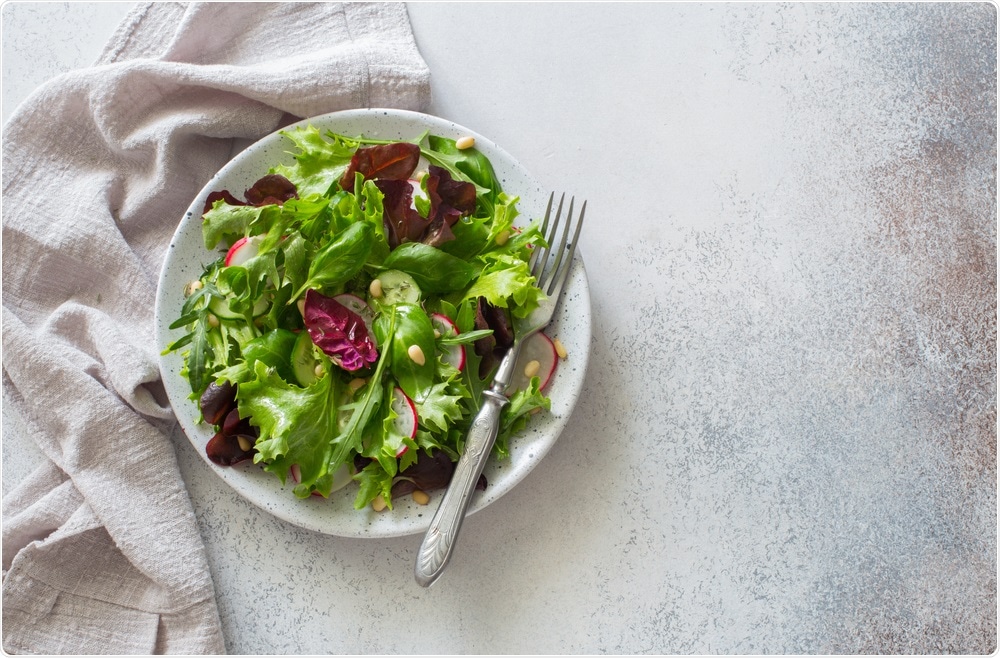New research has demonstrated that mild streams of water transporting sound and tiny air bubbles can remove bacteria from salad leaves more effectively when compared to existing washing techniques used by consumers and suppliers.

Salad. Image Credit: annata78/Shutterstock.com
In addition to reducing food poisoning, these discoveries could cut down food waste and hold important implications for the rising threat of anti-microbial resistance.
Leafy green vegetables and salad may be polluted with harmful bacteria at the time of growing, harvesting, preparation, and retail, resulting in outbreaks of food poisoning that may be lethal in vulnerable groups.
Since there is no cooking process to decrease the microbial load in fresh salads, washing is crucial both by the supplier and the consumer.
It is not recommended to wash with detergent bleach, soap, or other disinfectants, and the crevices in the leaf surface imply that washing with plain water is likely to leave an infectious dose on the leaf. And even if chemicals are utilized, they may not enter the crevices.
In the latest study, published in the Ultrasound in Medicine and Biology journal, researchers employed acoustic water streams to wash spinach leaves that were directly sourced from the field crop and subsequently compared the outcomes with leaves washed in plain water at the same level of velocity.
Our streams of water carry microscopic bubbles and acoustic waves down to the leaf. There the sound field sets up echoes at the surface of the leaves, and within the leaf crevices, that attract the bubbles towards the leaf and into the crevices.”
Timothy Leighton, Study Lead and Professor, University of Southampton
Leighton, who developed the technology, added, “The sound field also causes the walls of the bubbles to ripple very quickly, turning each bubble into a microscopic 'scrubbing' machine. The rippling bubble wall causes strong currents to move in the water around the bubble, and sweep the microbes off the leaf. The bacteria, biofilms, and the bubbles themselves, are then rinsed off the leaf, leaving it clean and free of residues.”
The results demonstrated that the microbial load on specimens washed with the acoustic streams for a couple of minutes was considerably lower six days following cleaning than on samples cleaned without the added bubbles and sound. Moreover, the acoustic cleaning did not cause any additional damage to the leaves and showed the ability to prolong the shelf life of food, which has significant sustainability and economic implications.
Enhancing the way food providers wash fresh produce could play a crucial role in fighting the threat of growing anti-microbial resistance. In the United States and Canada, there were deadly outbreaks of various strains of E. coli on romaine lettuce back in 2018 and 2019, and samples collected from humans infected contained strains that were resistant to antibiotic drugs.
I am very grateful to Vitacress and EPSRC for funding my PhD. I came from an engineering background, and took Professor Leighton’s classes, but he told me that I could be a trans-disciplinary PhD student, and become a microbiologist whilst increasing my engineering skills. I am also very grateful to Sloan Water Technology Ltd.: They opened up their laboratories for use by students like me, so that I can keep working on my experiments.”
Weng Yee (Beverly) Chong, PhD Student, University of Southampton
Chong, who was also a part of the research group, added, “It is an exciting environment to work in because they are doing so much inventive work to combat the pandemic and infections as a whole.”
Earlier as part of her Ph.D., Beverly has investigated how the technology could decrease the infection risk to horses and other livestock via hay cleaning.
The study was sponsored by Vitacress.
“Ensuring food safety for our products is an essential requirement. At Vitacress, we wash our produce in natural spring water, and this type of ground-breaking new technology helps to enhance our process whilst ensuring our commitment to protect the environment is maintained. We are always interested in new developments and are excited to see the results of this research,” concluded Helen Brierley, Group Technical Director.
Source:
Journal reference:
Chong, W. Y., et al. (2021) The Possibilities of Using Ultrasonically Activated Streams to Reduce the Risk of Foodborne Infection from Salad. Ultrasound in Medicine and Biology. doi.org/10.1016/j.ultrasmedbio.2021.01.026.